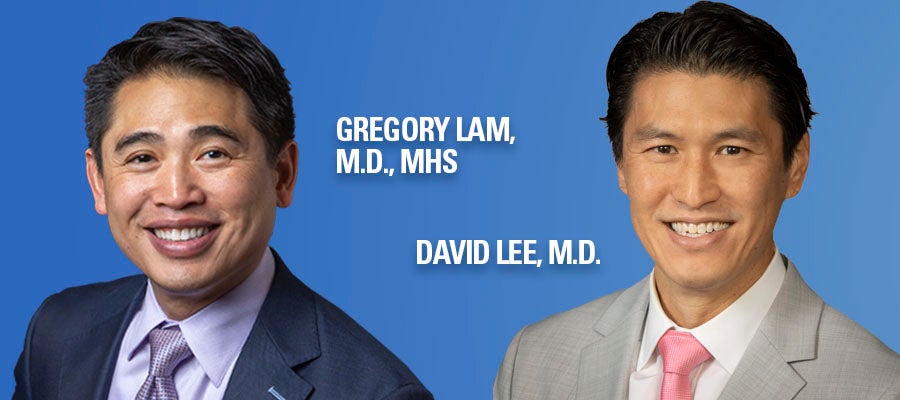Cultivating Change Together: Improving Asian American Health Outcomes

According to the U.S. Census Bureau report, Asian Americans account for 7% of the U.S. population — totaling over 24 million people. Between 2000 and 2023, Asian Americans were the fastest growing minority group, increasing by 103%.[1]
By 2060, Asian Americans are projected to make up 9% of the U.S. population, accounting for around 39 million people.[2] Despite this increase, the health challenges faced by Asian Americans are largely unrecognized.
This Q and A features David Lee, M.D., chair of the IFDHE Leadership Council, president of OhioHealthy Medical Plan, and vice president at OhioHealth Employer Solutions; and Gregory Lam, M.D., MHS, vice president of Ohio Asian American Health Coalition and co-chair of the Ohio Institute of Communities of Color.
Lee and Lam discuss the health challenges that Asian Americans face and what hospitals can do to reduce the disparities.
Lee: What do you think is one of the most pressing health concerns for Asian Americans?
Lam: I would say the most pressing issue is the general lack of recognition and understanding of the significant health disparities experienced by Asian Americans in the U.S.
Because of the Model Minority Myth — the racial stereotype that depicts Asian Americans as a successful, high-achieving minority group but ignores the discrimination and challenges they experience — the health inequities of Asian Americans are frequently overlooked. Asian Americans are therefore often left out of social and health policy considerations, which result in poor health outcomes that are largely unrecognized and therefore perpetuated.
DL: What are some examples of these health disparities?
GL: Health disparities in cardiovascular death rates, smoking cessation, diabetes screening, hepatitis and mental health have been widely reported. But perhaps the most striking example of disproportionate health outcomes comes from the COVID-19 pandemic.
Because Asian Americans were systematically overlooked during the state and federal public health discussions, they were disproportionately exposed to COVID-19, had the lowest rates of testing and were excluded in the initial vaccination efforts. As a result, Asian Americans were 49% more likely to die from COVID-19, had a 57% higher likelihood to be hospitalized and had a 24.7% excess death rate compared to white patients.[3]
The COVID-19 response is one of many examples of how the exclusion of Asian Americans in public health adversely affects the health of our populations.
DL: Why do you think these disparities exist?
GL: Historically, Asian Americans have been under-represented in research and epidemiologic surveys. Since 1992, only 0.17% of the National Institute of Health (NIH) budget and 0.01% of published articles included Asian American participants. Although AAs comprise 7% of the U.S. population, they have been represented in only 1.7% of therapeutic drug trials.[4] And in this research, Asian Americans are categorized into one “Asian American” group for statistical purposes, rather than individually considered for each ethnic group. This practice of aggregating Asian American subgroups has the detrimental effect of masking unique health disparities for specific Asian American populations.
For instance, the rates of diabetes and hypertension are lower for Asian Americans compared to other racial groups, but this buries the statistically higher rates of these diseases for Filipino and South Asian populations. In one of the largest studies that examined the effects of aggregated data for Asian subgroups, the researchers found that combining all Asian American and Pacific Islander subgroups for statistical purposes masked a variety of health risks for specific Asian ethnicities.[5]
DL: What can we do to reduce the health challenges confronting Asian American communities?
GL: There are several areas for opportunity, but we can start with a few such as:
- Increase participation of Asian Americans in research. This is critical to our understanding of the nuanced differences in Asian ethnic subgroups. Crucial to this is the NIH All of Us Research initiative, which will create the most comprehensive research database in the U.S. This will broaden our understanding of the unique health issues for each Asian American ethnicity.
- Strengthen community coalitions to promote health equity. In particular, there is an expanding role for community health workers to bridge patients with health care providers and social services.
- Promote education about health disparities for Asian Americans. Hospitals, medical and nursing schools, and community health departments can play a significant role in promoting health equity and cultural competency with their medical providers.
- Increase advocacy efforts at the local and national levels will be vital to raise awareness of the health inequities experienced by Asian Americans in the U.S.
References
- The Power of Asian American”, Asian Pacific American Chamber of Commerce https://www.apacc.net/the-power-of-asian-america
- U.S. Census Bureau Projections Show a Slower Growing, Older, More Diverse Nation a Half Century from Now” US Census Bureau. https://www.census.gov/newsroom/releases/archives/population/cb12-243.html#:~:text=The%20Asian%20population%20is%20projected,percent%20in%20the%20same%20period
- Kaiser Family Foundation & Epic Health Research Network, September 2020.
- Clinical Trial Diversity and AANHPI. APIAHF, NYU Center for Study of Asian American Health, January 2021
- Gordon, N.P., Lin, T.Y., Rau, J. et al. Aggregation of Asian-American subgroups masks meaningful differences in health and health risks among Asian ethnicities: an electronic health record-based cohort study. BMC Public Health 19, 1551 (2019). https://doi.org/10.1186/s12889-019-7683-3
